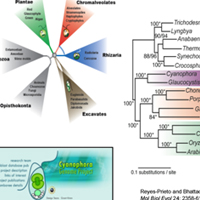 How was photosynthesis established in eukaryotes? To gain insights into this fundamental step in the evolution of our planet, we are determining to high coverage the 140 million base pair nuclear genome sequence of the unicellular alga Cyanophora paradoxa. Cyanophora is a member of the remaining group of photosynthetic eukaryotes (Glaucophyta) that still lacks a complete genome sequence. The single cyanobacterial primary endosymbiosis that gave rise to all plastids (e.g.,chloroplasts) occurred in the common ancestor of Cyanophora, other algae and plants. This was a pivotal and ancient (~1.5 billion years ago) event in the Earth’s history that laid the foundation for modern terrestrial ecosystems. A critical step in plastid establishment was the transfer of endosymbiont genes to the "host" nucleus. It is unclear whether this massive transfer was limited to genes strictly involved in plastid metabolism or whether the host profited from the captured genome to explore other novel functions via recruitment of genes from the cyanobacterium. The Cyanophora genome sequence will enable us to rigorously test this idea in a relatively "simple" algal model. Beyond its contribution to understanding endosymbiosis, the Cyanophora genome sequence will allow countless other insights, which include identifying a set of core genes shared by algae and plants that can be studied in detail to understand the origin of plant−specific characters. In addition, the Cyanophora genome will be invaluable for guiding the annotation of the genomes of plants and other protists.
How was photosynthesis established in eukaryotes? To gain insights into this fundamental step in the evolution of our planet, we are determining to high coverage the 140 million base pair nuclear genome sequence of the unicellular alga Cyanophora paradoxa. Cyanophora is a member of the remaining group of photosynthetic eukaryotes (Glaucophyta) that still lacks a complete genome sequence. The single cyanobacterial primary endosymbiosis that gave rise to all plastids (e.g.,chloroplasts) occurred in the common ancestor of Cyanophora, other algae and plants. This was a pivotal and ancient (~1.5 billion years ago) event in the Earth’s history that laid the foundation for modern terrestrial ecosystems. A critical step in plastid establishment was the transfer of endosymbiont genes to the "host" nucleus. It is unclear whether this massive transfer was limited to genes strictly involved in plastid metabolism or whether the host profited from the captured genome to explore other novel functions via recruitment of genes from the cyanobacterium. The Cyanophora genome sequence will enable us to rigorously test this idea in a relatively "simple" algal model. Beyond its contribution to understanding endosymbiosis, the Cyanophora genome sequence will allow countless other insights, which include identifying a set of core genes shared by algae and plants that can be studied in detail to understand the origin of plant−specific characters. In addition, the Cyanophora genome will be invaluable for guiding the annotation of the genomes of plants and other protists.